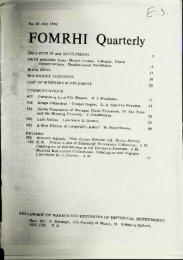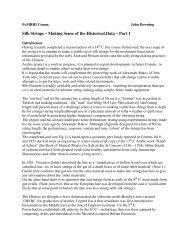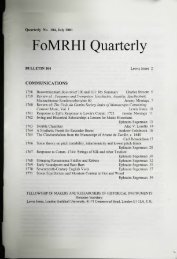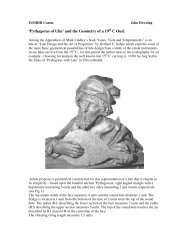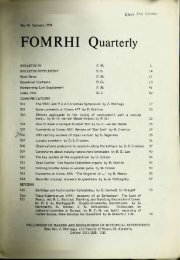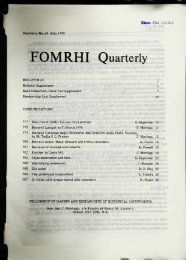• I f - FoMRHI
• I f - FoMRHI
• I f - FoMRHI
You also want an ePaper? Increase the reach of your titles
YUMPU automatically turns print PDFs into web optimized ePapers that Google loves.
24-<br />
The evidence of sizes in the drawing of the viole da braccio family by Virgiliano (// Dolcimelo<br />
(c. 1600), p. [95]) also argues against Boyden's interpretation. In that drawing, there is a<br />
rather larger size difference between the tenor and bass than there is between the soprano and<br />
tenor. There is no fourth size. If Boyden's soprano tuning was right, the larger size difference<br />
would be between the soprano and tenor, the other way around. The Hayes interpretation fares<br />
somewhat better, predicting a smooth progression of sizes, as there is with Virgiliano's<br />
drawings of the viols. A proper explanation that fits this evidence is given below.<br />
Sizes<br />
The pitches given by Zacconi (and correctly reported by Hayes) imply that the viole da braccio<br />
were large instruments, all larger than the violino. The sizes can be estimated from the tunings<br />
by the method of Comm. 1545, which assumes that the highest stress a gut string would be<br />
tuned to was the highest derived from Praetorius's information giving string stops and pitches,<br />
and that the maximum open-string ranges of bowed instruments with single string stops<br />
through most of the 16th century was two octaves. The most probable pitch standard was<br />
corista (a' = about 383 Hz). The possible string-stop ranges would then be 46-55 cm for the<br />
soprano tuned toe g da', 69-82 cm for the tenor tuned to F c g d' and 103-123 cm for the bass<br />
tuned to BBb F c g. No matter how one varies the assumptions within reason, the sizes remain<br />
indeed large.<br />
There are a number of 16th century Italian pictures of fiddles, with sizes from rather smaller<br />
than a violin to rather larger than a violin, but none anywhere near as large as the tenor and<br />
bass sizes above (such large sizes can be seen in pictures of French and German fiddles). This<br />
leads me to postulate that the pitches reported by Zacconi represented only the pitches on<br />
keyboard instruments that the strings were tuned to, but the actual pitches of the viole da<br />
braccio strings were an octave higher. This hypothesis has the advantages over the original<br />
octave specification of, in addition to solving the conflict with the sizes in pictures, also fitting<br />
the size distribution in Virgiliano's drawing, and providing the correct sizes, as well as the<br />
correct size names, of the members of the family that survived through the 17th century.<br />
With this hypothesis, the above sizes are halved. The soprano tuned to c' g' d" a" would have<br />
a string stop of 23-27 cm, the tenor tuned to/c' g' d" would have a string stop of 34-41 cm,<br />
and the bass tuned to Bbfc'g' would have a string stop of 52-61 cm. The bass would have<br />
been suspended against the front of the player's body with the strings vertical. Played this<br />
way, there was no impediment to the bass size being close to the maximum of its range for best<br />
response on its lowest strings. Comfort in holding against the shoulder would keep the tenor<br />
size small within its range. These biases within the ranges explain the relative sizes on<br />
Virgiliano's drawing.<br />
* * *<br />
The second section on the family of viole da braccio (after 1600) of Comm. 1562 also needs to<br />
be withdrawn, and replaced by the following:<br />
The viole da braccio in Monteverdi's Orfeo (1607), and later<br />
The old violino and viole da gamba were included in the 1589 Intermedii, but not any viole da<br />
braccio. Viole da braccio were still frowned upon as only dance-band instruments. What<br />
changes Monteverdi required to use them in his highly respectable music can be judged by<br />
considering the ranges of music they played in Orfeo.<br />
When Monteverdi indicated that a piece was played on viole da braccio, he did not specify<br />
which members of the family played which line. The highest parts go as high as a" with an<br />
occasional b". They could have been played on Zacconi sopranos tuned c' g' d" a", but





